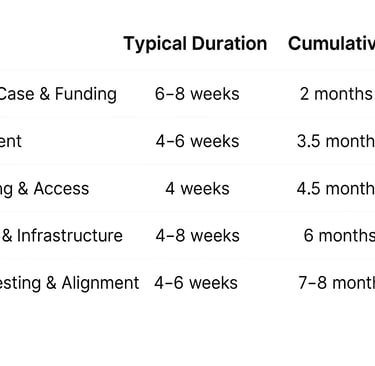I know, I know — I’m fully aware that SAP BusinessObjects BI 4.3 only goes end of life on December 31st, 2026 (see SAP Note 3349500 – BI 4.3 End of Life). But hear me out on why, in reality, there’s only about nine months left to act if you want to successfully upgrade to BI 2025 without chaos, stress, or an all-nighter in Q4 next year.
Let’s break this down.


Only Nine Months Left of BI 4.3 (And Yes, This Title May Be Clickbait)
"If you’re still planning your BI 2025 upgrade ‘sometime next year,’ you’re already running late — the calendar just hasn’t told you yet."
About the Author
Hi, I'm Clint and I've been knee-deep in the SAP Business Objects world for over 25 years now. Yeah, I know, longer than I care to admit. My first installation was way back in SAP BI 6.5 - back when Desktop Intelligence was still a thing. Needless to say, I've seen it all.
After running two wildly successful global SAP Analytics consulting firms, being a SAP Mentor, and speaking on all things SAP Analytics and SAP Business Objects around the world, I'm here to help. I've moved to the "employee of one" model, and I'm available worldwide to assist you with your SAP BO upgrade.
I get it - I know how SAP is moving towards a "cloud first" approach, just like every other big vendor out there. But I also know that customers need to keep their on-premise BI 4.x implementation running alongside SAP Analytics Cloud (SAC), as there's no seamless migration path to SAC. With all the lower versions of Business Objects, except for BI 4.3 and BI 2025, now being out of support, the need to upgrade for many customers is pressing. So, feel free to connect with me below to start the conversation or connect with me here or you can find out more about me here.


“With over 25 years in SAP Analytics, I’ve guided numerous businesses through seamless upgrades, ensuring minimal downtime and optimal performance.”
The Year Is Practically Done
As I write this — November 11th, 2025 — the year is basically over. If you’re in the Southern Hemisphere, you’re heading into the Silly Season with summer holidays fast approaching. In the Northern Hemisphere, especially in the U.S., Thanksgiving is around the corner, and that’s followed closely by Christmas and New Year.
Across retail and large enterprise, code freezes kick in, budgets are closed, and major projects go on hold. In short, from now until the end of January, almost nothing new gets started.
Which means, in terms of project reality, your earliest real start date is February 1st, 2026.
That’s your starting gun.
The Real Deadline Isn’t December 2026 — It’s October 2026
Sure, BI 4.3 goes end of life on December 31st, 2026. But if you’re leading an upgrade project, your actual go-live can’t be in December. You’ll need a stable environment, time for regression testing, and breathing room before the shutdown.
That means your real cutoff is more like October 31st, 2026 — the last possible moment you can realistically go live before the end-of-year change freeze.
Now let’s do the math: February to October = nine months.
That’s it. Nine months of working time to plan, procure, provision, build, test, and go live.
The Hidden Time Thieves
Here’s where most BI upgrade timelines unravel — not in the technical side, but in the process. These are the silent killers of project timelines:
1. Business Case and Funding
For most enterprises, the first step is securing funding. That means writing a business case, presenting to governance boards, and waiting for approvals. Even with momentum, that’s six to eight weeks gone.
2. Procurement
Procurement can feel like an obstacle course. Vendor evaluations, contract renewals, legal reviews — they all take time. Add another four to six weeks easily.
3. Onboarding and Access
When customers ask, “When are you available?”, I usually joke that I’ll be available before you can get me online. Between VPN setup, security clearance, and IT provisioning, onboarding external consultants can easily eat another month or more.
4. Hardware and Infrastructure Provisioning
Even if you’re cloud-hosted, there’s still coordination between infrastructure teams, third-party vendors, and SAP administrators. Hardware and network provisioning cycles are no longer in-house — they’re often outsourced, and lead times are getting longer, not shorter.
Budget another one to two months here.
5. Internal Testing and Resource Alignment
Finally, don’t underestimate the challenge of internal resourcing. Your key testers and report owners are juggling multiple projects. Coordinating test cycles, UAT, and sign-off can drag timelines unless it’s planned months in advance.
“BI upgrades don’t fail because of technology — they fail because people underestimate how long ‘nothing happens’ takes.”
Visualising the Time Thieves
You get the picture — too much, too much, too much. The nine-month window shrinks fast.
So, How Much Time Do You Really Have?
If you start planning in February 2026 and aim to go live by October 2026, that’s a nine-month window. But once you layer in business case development, funding approvals, procurement, hardware provisioning, onboarding, and testing, your effective execution time drops closer to four to five months of actual project work.
And that’s tight.
The Point of This Article
This isn’t a scare piece — it’s a reality check. Too many organizations wait until “next quarter” to start, not realizing they’ve already lost their buffer. BI 2025 is a major upgrade, not just a patch. The sooner you start planning, the smoother and cheaper the transition will be.
If you want to dig deeper, I’ve written a few related articles worth revisiting:
Upgrading to SAP BI 2025: What Features You’re Losing and Keeping
The End of SAP BI Analysis for Office — What You Need to Know
SAP BI 2025 Is Live — How Does This Affect Your Existing Environment?
Each of those pieces expands on the strategy, risks, and timelines I’ve mentioned here.
Final Thought
So yes, technically BI 4.3 has another 13 months before sunset. But in project terms — factoring in real-world calendars, approvals, onboarding, and testing — you’ve got nine months left to make it happen.
If you’d like to discuss your upgrade roadmap or need help mapping your timeline, reach out. Even a short scoping call now could save you months next year.



My SAP Analytics Blog

Connect with me today to ensure your SAP BI 2025 Upgrade is a success !
Alternatively please send an email to sapupgrades@clintvosloo.com






